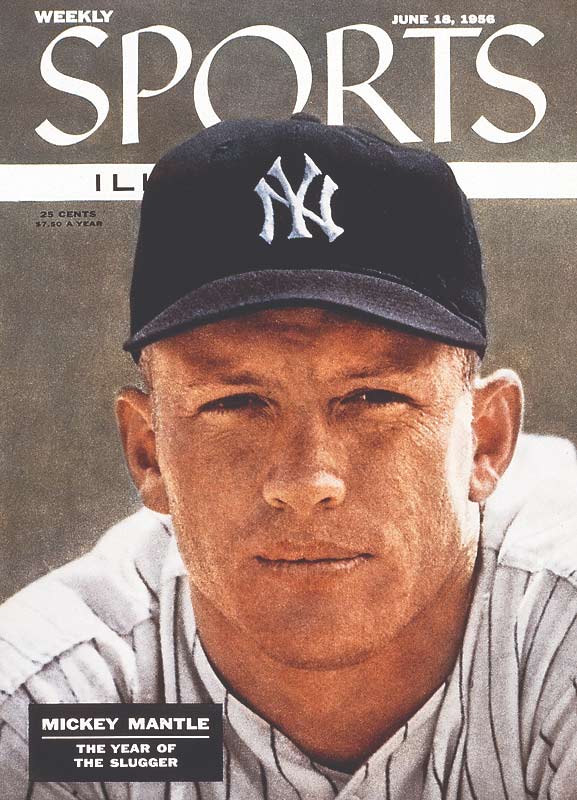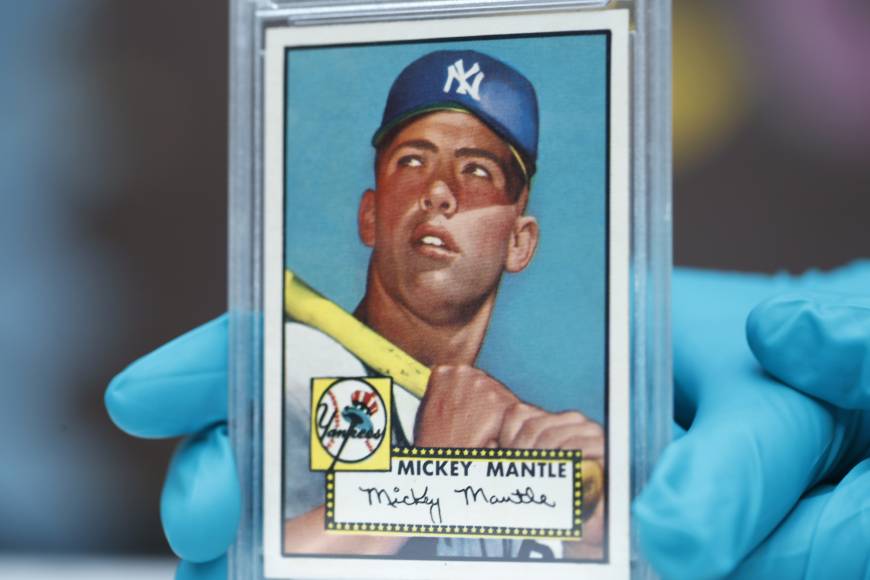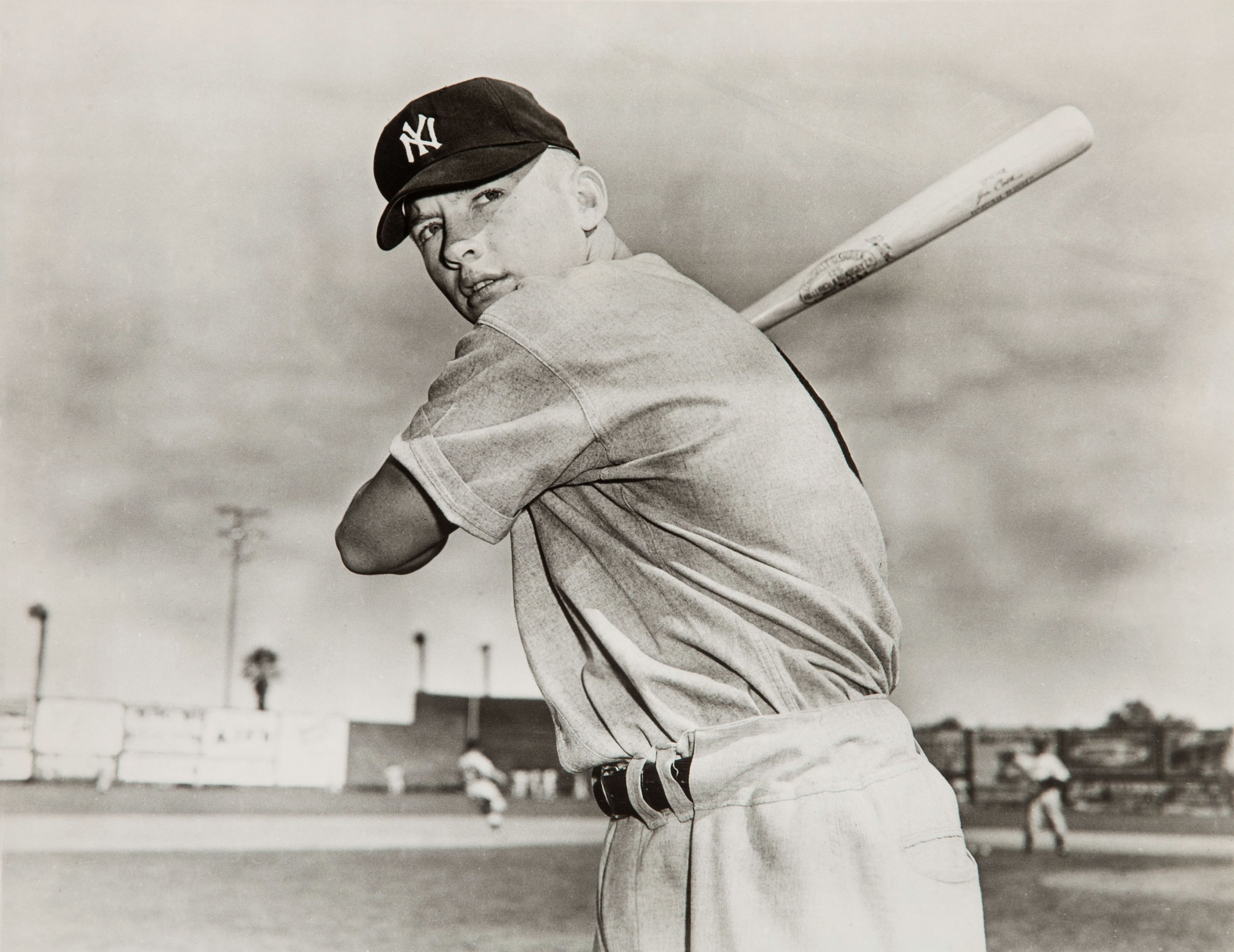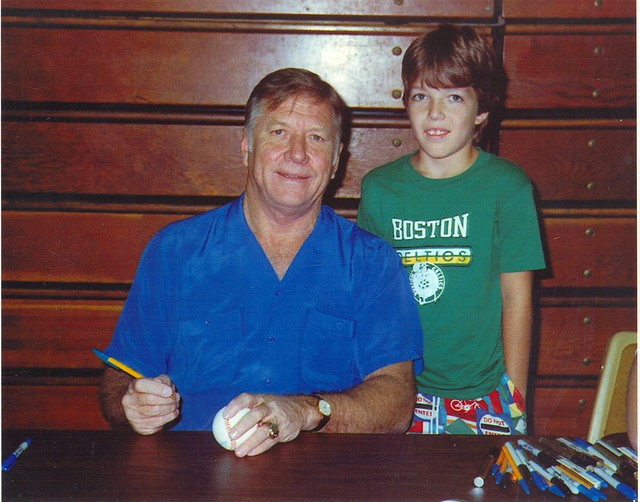He was unlike any other baseball star in America, a blond-haired boy from the heartland whose raw power and mythical purity made him a hero
-
September/October 2019
Volume64Issue4
History professors Roberts and Smith recently co-authored A Season in the Sun: The Rise of Mickey Mantle (Basic Books), from which this essay is adapted. The book traces Mantle's ascendance as an icon of the 1950s and baseball's place in American culture.

Look at the determination on Mickey Mantle’s face—the resolve in his fierce blue eyes, his flexed jaw, and the hardness around his mouth. Look at the power—the prizefighter’s cheekbones, the bull’s neck, and the hint of a slugger’s shoulders. Is it the face of weakness, the look of a man fragile enough to crack into a million pieces?
Mantle’s chiseled physique looked like the ideal body of a power hitter, a creation of Michelangelo sculpted out of marble. Wonderstruck by his muscled, compact frame, sportswriters and teammates tried not to stare when he ambled through the locker room, nearly naked, wearing only a towel, his perfectly V-shaped torso, barreled chest, hard stomach, and wide back on display. Built like a lead miner, with broad, sloping shoulders, bulging biceps, and Popeye forearms, Mantle was, in baseball parlance, country strong.
Hy Peskin’s 1956 Sports Illustrated cover photo reveals the intensity and rugged strength of baseball’s most famous player. In that season—branded the “Year of the Slugger” by the magazine—his career held only great possibilities; baseball immortality itself was within his reach. His physical gifts—power, speed, and agility—made it seem like there were no limits to what he could do on a baseball field.
Yet, for all of his attributes, Mantle’s biographers have emphasized his overriding weakness. Too often they have presented his life as seen darkly through a rearview mirror, interpreting many events during his baseball career as a way station along the road to alcoholism. “Mickey Mantle’s life was spent waiting for a death that seemed just around the corner,” biographer David Falkner wrote. Similarly, in her fine biography, Jane Leavy observed, “Mantle fit the classical definition of a tragic hero.”

By the summer of 1995, alcohol-induced cirrhosis of the liver, hepatitis C, and cancer had left him a shell of the man he had been in the 1950s, when, strong and tanned, he had graced the cover of American magazines and thrilled baseball fans on the diamond. Only later would his heavy drinking define the arc of his life.
This focus ignores much of the joy of his life—the joy he discovered in the game and the joy spectators experienced watching him play. To fully understand the man, his impact on baseball, and what he meant to America, it is necessary to look at his life as he lived it, not as a study in retrospection. That means returning Mantle to the 1950s, when he became the most celebrated athlete in the country and reigned as the king of the National Pastime.
In 1956, only injuries stood between Mickey Mantle and greatness. The Mantle the fans knew—the one they saw at Yankee Stadium, watched on television, and read about in Sports Illustrated—was not a drunk. He was a latter-day legend. In the lore of Mickey Mantle, it is an often-told tale. As well it should be. It’s a story of two of the greatest players—and arguably the two most iconic—of the early post–World War II era, set against the backdrop of the excitement and pageantry of a Subway Series between the New York Yankees and the Brooklyn Dodgers, at a time when baseball was still the king of all American sports. It is fitting that virtually every book on Mantle pays homage to “the play.”
Before the 1952 World Series, Yankees manager Casey Stengel cornered his young center fielder for a lecture on the wily habits of Dodgers star Jackie Robinson. Jackie, Stengel explained, was the most aggressive base runner in the game. He was known for stretching a single into a double or blazing around second to turn a double into a triple. In a primal sense, he challenged the manhood of outfielders, calling into question whether they had the talent and the nerve to throw him out. Mickey listened, knowing he had the arm. But the nerve . . . that was another matter.
In the eighth inning of Game Three, with the Dodgers leading the Yankees 2–1, Robinson ripped a low line drive into center field. Charging down the first base line, he reached full speed in three strides. Rounding first, his spikes kicking dust, he challenged Mantle, who fielded the ball on one hop. Suddenly the game became a chess match, a test of wits between the young outfielder and an experienced, daring base runner.

Holding the ball shoulder high, Mantle eyed Robinson, who had slowed to a dance between first and second. Mickey cocked his arm as if he were going to fire it toward first, daring Jackie to make a move. Robinson hesitated, then streaked toward second. Mantle had conned him into running for the extra base and then threw him out by what seemed like half a city block. When it was over Jackie smiled and tipped his cap. Mickey grinned. He had outsmarted the great Jackie Robinson.
On the game’s greatest stage, Mantle demonstrated that he had the intelligence, instincts, and ability to make “the play.” No wonder he recalled it as one of his most treasured memories. No wonder his biographers and a legion of sportswriters have fondly recounted the episode. Some consider it one of his greatest World Series plays. As much as his tape-measure home runs, it signaled the arrival of Mickey Mantle, the Wonder Boy of the 1950s.
It’s a marvelous story. There is only one small problem with the tale. It never happened. Mickey did not bait and trap Jackie. Robinson did not attempt to reach second. In fact, he advanced to third base on a single by Roy Campanella and then scored on a hit by Andy Pafko. The Dodgers won the game and took a 2–1 lead in the series. Anyone reading the New York newspapers the next day on October 4, 1952, would have seen it recorded that Robinson crossed home plate. The following spring, writing a magazine profile of Mantle, Milton Gross, an eyewitness reporter, noted that after Robinson hit the ball into center field and rounded first base, he “stopped, stumbled, got to his feet again, and then scrambled back to first.”
The significance of “the play” is not that it didn’t happen but that it is remembered as if it did. Years later, Mantle confidently recalled throwing out Robinson. “I’ll never forget it,” he said. Perhaps Mickey confused the play with a similar one in another game. But a close inspection of every Yankees and Dodgers World Series contest that Mantle and Robinson played in 1952, 1953, 1955, and 1956 reveals that Mickey never threw Jackie out at second. It turns out that Mantle was an indifferent student of his own career. In that regard he was like his teammate Yogi Berra, who once commented, “I never said most of the things I said.”
Journalists and biographers have retold Mickey’s tale, perpetuating a mythology that started with his own hazy memories. Discerning the truth of Mickey’s world, especially during the 1950s, demands casting a skeptical eye on his many ghostwritten autobiographies and the popular reminiscences of the era. According to the conventional baseball narrative, Mantle played during a more innocent time. After he died in 1995, Sports Illustrated’s Richard Hoffer wrote, “Mantle was the last great player on the last great team in the last great country, a postwar civilization that was booming and confident, not a trouble in the world.” In the introduction to Mantle’s memoir of the 1956 season, coauthor Phil Pepe wrote of the era that it was “a wonderful time in this country when everyday life was much less complicated.”
Yet romanticizing Mantle’s place in the “golden age” of baseball and the “happy days” of the 1950s distorts reality. Only when we ask how the Cold War and the culture of New York shaped American attitudes toward Mantle can we begin to understand why baseball needed a hero like him. In the making of Mickey Mantle, context was as important as his outsized talent.
With the help of the very best sportswriters in New York—the capital of baseball—he emerged as an American icon. In the decade after World War II, when New York’s three major league teams dominated baseball, the city was still very much a newspaper town. The papers connected baseball fans to Mantle throughout the day. Drinking their morning coffee, sports fans read Arthur Daley and Gay Talese at the Times or Red Smith of the Herald-Tribune; the Daily News’s Dick Young and the Daily Mirror’s Walter Winchell entertained readers on their subway rides to work; the Post’s great columnists, Jimmy Cannon and Milton Gross, absorbed their attention during the ride home; and Frank Graham at the Journal-American or Dan Daniel of the World-Telegram and Sun helped them relax after dinner, offering the latest gossip and baseball news. The most influential New York scribes shaped Mickey’s popular image through their writing in Sports Illustrated, Sport, The Sporting News, Baseball Digest, Saturday Evening Post, Newsweek, Time, and Look. In 1956 Mickey Mantle became baseball’s cover boy, publicized and photographed from one coast to another.
Yet the writers did more than report feats; they fabricated baseball’s myths and produced American heroes. “Most mythology,” David Halberstam wrote, “is manufactured in New York about American virtues; thus the mythologists are from New York, but the mythologized are preferably from Commerce, Oklahoma, or”—in the case of Joe DiMaggio, the son of Italian immigrants—“Fisherman’s Wharf.”
If Mickey Mantle had not existed, sportswriters and Yankees publicists would have invented him. And in a quite literal sense, they forged the Mickey Mantle Americans adored. Since 1920 sportswriters had helped create New York baseball legends. They transformed George Herman Ruth, a loud, boorish man, into the Babe, a jovial idol who loved children, candy, and soda pop as much as he did hitting home runs. They turned a distant, laconic DiMaggio into the incomparable Yankee Clipper, a reserved, classy paragon of excellence. They made Lou Gehrig, the reclusive son of German immigrants, into “the Pride of the Yankees,” a sentimental favorite who battled a debilitating and ultimately terminal disease with unmatched and unwavering courage.

The Yankees and their supporters in the press promoted baseball stars because New Yorkers demanded excellence from the team that embodied the city’s competitive values. In 1968, Mantle’s final season, historian Bruce Catton recognized as much, writing, “The Yankees perfectly represented what might be called the New York Idea, which held that New York had and was the best of everything. No matter what line of work a man was in—finance, industry, communications, the arts, sports, or fashion—he was not really in unless he was in New York. New York made the pace; it led the way, and everybody else had
to follow and like it.”
Mickey Mantle, the ball player from rural Oklahoma, was next in the assembly line of New York creations. It was all planned from his first glorious spring training camp when he began knocking the ball prodigious distances. That was in 1951, but his anointment was premature.
Over the next four seasons, he struggled to fulfill the expectations thrust upon him by the city’s hero makers. Instead of a wunderkind, he was an enigma. Fans questioned his character and determination. Then, in 1956, it all came together. After years of disappointments, frustration, and a variety of injuries, in 1956 he confirmed his greatness. It was his best season ever. He performed magnificently, pounding tape-measure home runs into the bleachers of Yankee Stadium, making crucial plays during the World Series, and winning the Triple Crown, a rare achievement that marked his ascendance as the best player in the game.
That season Mantle joined Ty Cobb, Rogers Hornsby, Lou Gehrig, and Ted Williams as the only players who had led both leagues in home runs, batting average, and runs batted in (RBIs) in a single season. During their Hall of Fame careers Babe Ruth, Joe DiMaggio, Stan Musial, and Willie Mays failed to qualify for this elite club. This shortlist represents something more significant than the answer to a trivia question. The Triple Crown is at the very heart of baseball’s hold on America. A testament of his greatness, Mantle’s statistical feat garnered his permanent place in history. More than other sports, baseball, Halberstam observed, depends on statistics because they give meaning to the game’s mythology. A player’s “performance is not fulfilling enough,” he wrote. “It must be shown in quantified heroics, records to be set and broken, new myths and heroes to replace the old.”
And in 1956 Mantle stepped out of the shadows of Ruth, Gehrig, and DiMaggio. For the first time in his career, the sun-bathed stage of Yankee Stadium truly belonged to him. There may have been a player who had a year close to Mickey Mantle’s perfect season, but none had a more euphonious name or better looks or was so well suited for the television age. He was unlike any other baseball star in America, the realization of Bernard Malamud’s protagonist in The Natural, a blue-eyed, blond-haired boy from the heartland whose raw power and mythical purity made him a hero.
Of course, there were always two Mickey Mantles—the man and the image—and New York’s celebrity-making culture shaped and eventually eroded both.

